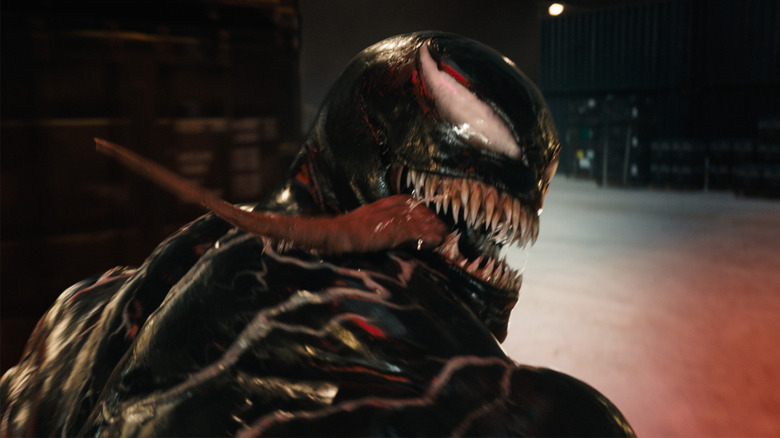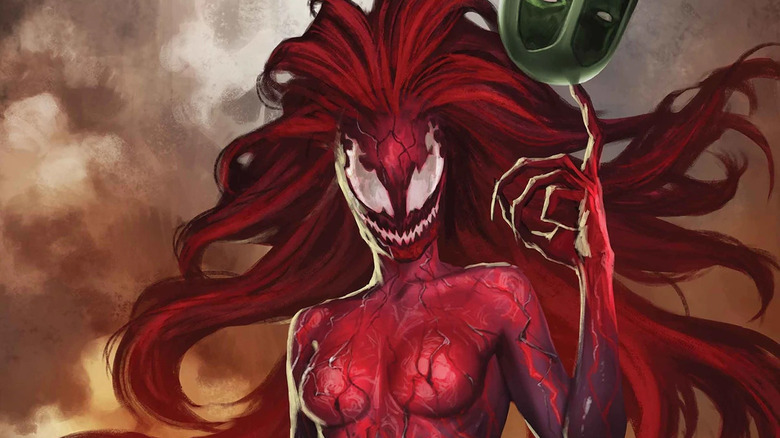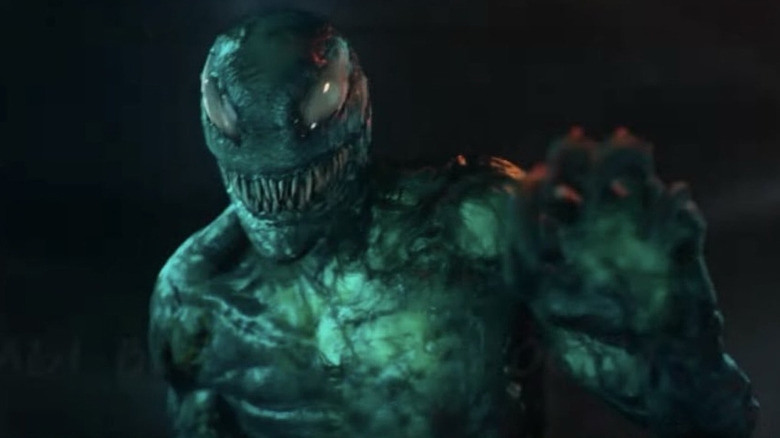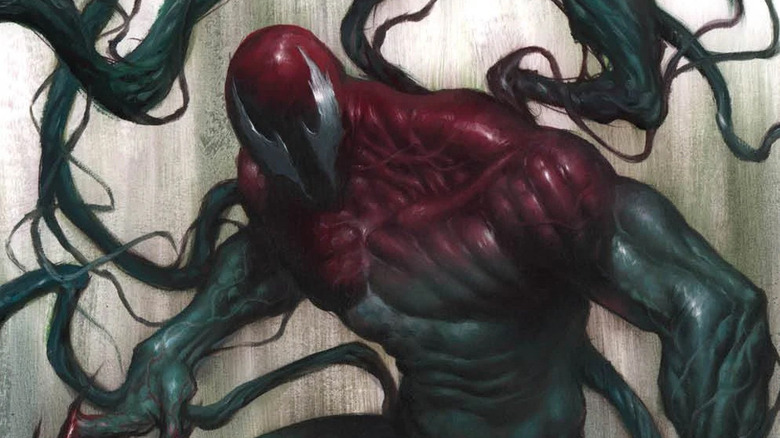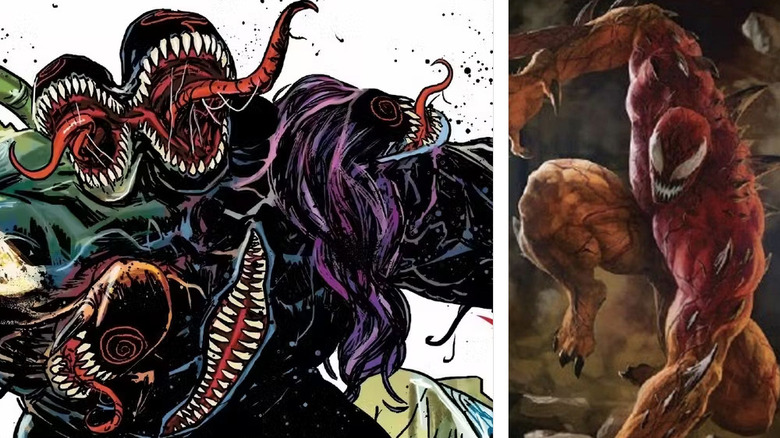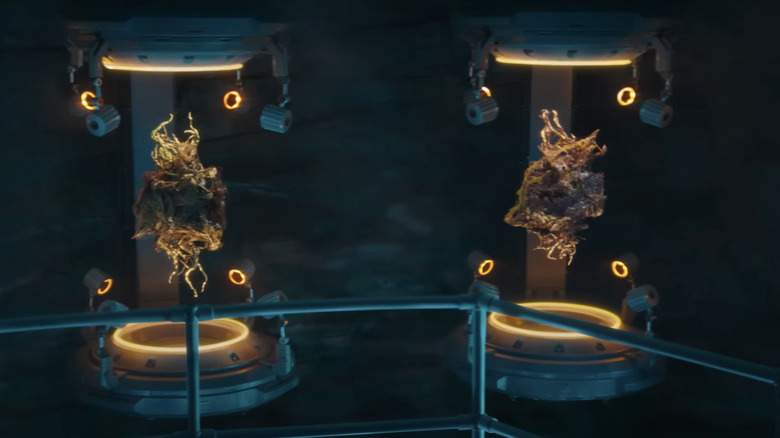Let's Try To Explain Every Marvel Symbiote In Venom 3 (The Movie Doesn't Make It Easy)
This article contains spoilers for "Venom: The Last Dance."
The first two movies in the "Venom" franchise gave the eponymous anti-hero and his new buddy Eddie Brock (Tom Hardy) a run for their money by having them go up against some deadly rival symbiotes. In 2018, the outdated but silly "Venom" saw the symbiote Riot merge with Life Foundation CEO Carlton Drake (Riz Ahmed), and the two teamed up in an effort to bring an entire race of symbiotes to Earth to bond with humanity, though each had their own very different motivations for doing so. In 2021, "Venom: Let There Be Carnage" (which almost had a better title) turned serial killer Cletus Kasady (Woody Harrelson) into the aforementioned symbiote Carnage after a piece of Venom was inadvertently consumed by the criminal when he bit Eddie's hand during a journalistic prison visit.
"Venom: The Last Dance" (read our review) also brings some new symbiotes to the table. However, rather than making them the villains of the story this time around, they actually end up being allies of Venom and Eddie Brock. It's the most symbiotes we've ever seen in a single movie, but the problem is that the introduction of all but one of them is rather unceremonious. In fact, the symbiotes feel like they're merely used as a convenient plot device and action element to fill the runtime rather than actually providing a satisfying version of characters that fans might recognize from Marvel Comics.
Having said that, we're going to do our best to determine which specific symbiotes are introduced in "Venom: The Last Dance," even though we're pretty sure that most of them were intentionally non-specific for a logical but dissatisfying reason.
Agony makes her grand entrance
This is easily the symbiote introduction that's made the most clear in "Venom: The Last Dance."
When we're introduced to Juno Temple's character Dr. Teddy Payne, she's waking up from a flashback dream that reveals a key detail about her life. When she was a teenager, she was hanging out with her brother on the beach, where he was dreaming of a future when he would be learning about space and extra-terrestrial life. Suddenly, a nasty thunderstorm rolls in, and while they're running back to their house for safety, lightning strikes Teddy through the left side of her body and kills her brother. Teddy went on to live out her brother's dreams of researching aliens, as she's now the scientist in charge of a secret government program that has collected and studied symbiotes that arrived on Earth. But she lives with a stream of lightning bolt-esque scars along the left side of her body and left arm, which hangs lifeless by her side.
Teddy is protective of the symbiotes, and she's desperate to learn more about them. So, when the military man Strickland (Chiwetel Ejiofor, previously of "Doctor Strange") and his shadowy, mystery boss who's never fully revealed take over the facility and create chaos in their pursuit of Eddie Brock and Venom, she's keen on making sure the symbiotes aren't harmed. Eventually, there's an attack on the facility by Knull's xenophage creatures, who are in pursuit of the codex within the bond of Eddie and Venom, and the symbiotes choose to fight back by bonding with random assorted scientists, becoming Venom-like in their appearance and trying to stop the xenophages.
In the midst of this climactic battle, Teddy escapes with a vial of one remaining symbiote. When one of her scientist friends is in danger, she breaks it open and lets the symbiote attach to her body in order to save them. The symbiote has a magenta hue, long hair, and electrical abilities along with the usual superpowers, and based on Teddy's previous experience with lightning and pain, this is clearly none other than Agony. Perhaps we'll see her again in another "Venom" movie.
Mulligan is not Toxin
Contrary to what many believed after the end of "Venom: Let There Be Carnage," former police detective Patrick Mulligan (Stephen Graham) does not become the symbiote known as Toxin in "The Last Dance." Instead, the symbiote that was inside Mulligan at the end of "Let There Be Carnage" has left his body, and now he's on the verge of death. But Dr. Teddy Payne's symbiote lab brings him in and injects him with one of the symbiotes they've retrieved, both so they can keep him alive and so they can communicate with the symbiote. Why they have never taken anybody else on the verge of death and injected them with a symbiote is beyond me, but this movie isn't exactly packed with sound logic.
When Mulligan is in better shape, the symbiote speaks to Teddy and Strickland and provides all the exposition they need about symbiotes, Knull, and the codex that he seeks from the bond between Venom and Eddie Brock. During one of these conversations, Mulligan transforms completely into his symbiote counterpart, and rather than being half-red, half-black with a green tongue, the symbiote form is fully green (maybe even teal?), and its lower half is a kind of snake-like body — meaning, this is clearly not Toxin.
However, what's really frustrating is that there's no indication as to who this symbiote might be. It never identifies itself with a name, and its appearance does not match any symbiote that has been seen or named in Marvel Comics. Yes, there's a green symbiote in Marvel Comics, but I think the link to that character is actually provided by another symbiote in "Venom: The Last Dance."
Lasher, is that you?
Lasher is the green symbiote that might otherwise make the most sense for Mulligan's transformation, but that namesake may fall on Dr. Sadie, a scientist character played by Clark Backo. Though she only has a small supporting role, it's clear that she feels sympathy for the symbiotes. After she briefly absorbs Venom in order to help Eddie Brock escape the facility takeover by Strickland, she then takes on another symbiote in the final battle.
For some reason, Dr. Sadie's defining trait is that she loves Christmas, and she expresses that year-round with a prominent Christmas tree broach that Strickland pokes fun at. That's why, when Dr. Sadie takes on a symbiote, she appears green with distinct red markings. The appearance of this symbiote is much more similar to Lasher, including the stabbing tentacles that emerge from her body while battling with the xenophage creatures, but the red isn't made quite as prominent on the symbiote's head as it is in Marvel's comic books. Plus, just like the other symbiotes, this one is never given a proper name, and we're left guessing whether or not it might be a specific one from Marvel Comics. Anyway, it doesn't really matter, because that symbiote is killed by xenophages too.
Hybrid (but not really) and Phage
The other two somewhat distinct symbiotes that we see only have the small possibility of actually being linked to their Marvel Comics counterparts.
First, there's Hybrid. At one point during the battle, two of the symbiotes merge into one, so there's one larger symbiote body with two heads on it. That's basically the only reason this could be Hybrid, but in actuality, this Marvel Comics symbiote is a combination of Riot, Phage, Agony, and Lasher, who survive by becoming one after being imprisoned by the Life Foundation and tortured. The appearance of a two-headed symbiote is likely just a nod to Hybrid rather than actually being that character, especially since it has such a prominent story arc in the comics.
Speaking of which, Phage is another symbiote that possibly appears, but the only indication that Phage might be there is seeing a symbiote that has a orange-beige kind of color. The symbiote appears to be a little more stocky than Venom or any of the other symbiotes we've seen, but that's its only real defining trait. Admittedly, this is more of a wild guess, but we're thinking that this symbiote isn't specifically Phage either, and there's actually a logical reason for the sheer lack of identification in almost all these symbiotes.
The rest don't have clear Marvel Comics ties
While it's frustrating that all the new symbiotes who appear in "Venom: The Last Dance" don't have names, and most of them don't have any clear defining traits that link them to symbiotes in Marvel Comics, there's a reason for that.
All of the new symbiotes we meet in "Venom: The Last Dance" are killed by xenophages. It wouldn't make sense for Sony Pictures to waste specific symbiotes if it knew they were going to be dispatched so quickly. By using more generic symbiotes, the film gets its CGI spectacle without ruining the potential for symbiote characters to have a more prominent role in future movies. That's probably why "The Last Dance" didn't turn Mulligan into Toxin too. It's not a satisfying explanation, but it makes sense.
This is just one of the many problems with "Venom: The Last Dance," but at least it means the film doesn't do a disservice to any of the symbiotes that fans might have an affinity for. At the very least, the movie gave Juno Temple a cool transformation and seems to have begun carving a path for Agony to exist in Sony's Marvel universe. Perhaps we'll see more symbiotes properly showing up if a fourth "Venom" movie comes together — and if the post-credits scene is any indicator, then Sony Pictures is certainly hoping for that to happen.
"Venom: The Last Dance" is playing in theaters everywhere now.
